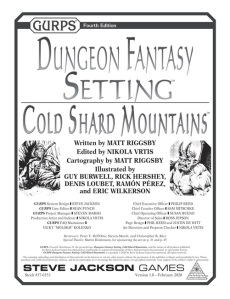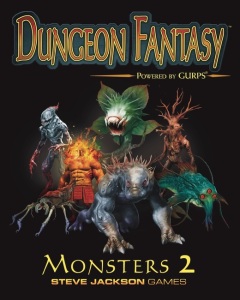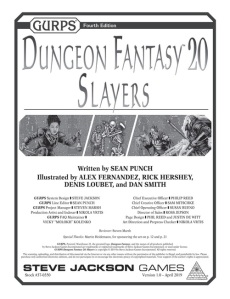Am 01.06.19 leite ich auf dem KURT in Mannheim ein kleines Einführungsabenteuer für GURPS DSA namens “Hexentanz” (aus der Anthologie Sphärenkräfte für diejenigen, die Spoiler vermeiden möchten). Voranmeldung ist unter den obigen Links möglich. Hier sind die Kurz-Biographien der vorgenerierten Charaktere, die ihr spielen könnt. Ihr könnt gerne mit Kommentar einen davon auswählen (Voranmeldung beim KURT vorausgesetzt).
Ailgrid Lindenfold – Weidener Kriegerin
Nicht alle Krieger sind von Stand, auch das wohlhabende Bürgertum schickt manchmal einen vielversprechenden Sprössling auf die Akademie. So geschah es auch mit der kleinen Ailgrid, die zuerst alles andere als begeistert war. Nach und nach gewöhnte sie sich aber ans Kämpfen, wobei ihr gehöriger Dickschädel ihr manches mal zugute kam. Ehre und Tradition waren der Akademie wichtig, ließen Ailgrid allerdings auch wenig aufgeschlossen für Neues und etwas vorhersagbar werden.
Kämpfen ist das Handwerk, das Ailgrid erlernt hat. Ob mit Axt, Bogen, Morgenstern oder Lanze. Sie kann mit allen ritterlichen Waffen umgehen. Die wichtigsten sind allerdings Schwert und Schild. Auch in der Wildnis und mit der Menschenführung kennt sie sich gut aus. Taktik, Strategie, Geschichtswissen und Sagen gehören auch zu ihren Kenntnissen. Die Tatsache, dass sie eine gute Reiterin ist, wäre von größerer Bedeutung, wenn sie nicht vor kurzem ihr Pferd verloren hätte.
Alrico Honorio Vascagni-Scirra – ein almadanischer Gelehrter
Eine Weile dachte Alrico, dass er immer wieder ein neues Studiengebiet finden könnte, aber irgendwann drehte auch seine wohlhabende Mutter dem ewigen Studenten den Geldhahn zu und er sah sich gezwungen mit seinem mannigfaltigen in vielen Semestern erworbenen Wissen hausieren zu gehen. Dabei träumt er eigentlich von Heldentaten, die der Kriegsgöttin gefallen und hat nicht umsonst lange Jahre mit dem Degen trainiert. Dass das Kriegshandwerk alles andere als romantisch ist, hat er bislang noch nicht mitbekommen.
Alrico kennt viele verschiedene Sprachen, hat Geschichte, Astronomie, Philosophie und leider auch Juristerei studiert. Er kann gut zeichnen – auch halbwegs leserliche Karten, wenn es nötig wird – und verfügt über ein phänomenales Gedächtnis. Mit Degen und Linkhand-Dolch sowie mit Fäusten und Knien weiß er sich auch ganz ordentlich zu wehren. Ein rondragefälliger Recke ist er damit aber noch lange nicht.
Cavarya Lucara Grimani – eine Liebfelder Kampfmagierin aus Bethana
Wenn sie nicht der Zufall ins verschlafenen Bethana verschlagen hätte, wäre das Straßenkind Cavarya wohl zu einer Streunerin herangewachsen, aber hier fiel den Magiern der Halle des Vollendeten Kampfes bald ihre magische Begabung. Die Ausbildung in den magischen wie nicht-magischen war ein solcher Segen für die junge Cavarya, dass sie die Werte der Akademie verinnerlicht hat und ein ausgeprägtes Ehr- und Pflichtbewusstsein aufgebaut hat, das sie – zusammen mit ihrem Hang zur Meditation weit weltfremder wirken lässt, als sie tatsächlich ist.
Neben den grundlegenden wissenschaftlichen Kenntnissen einer Magierin, verfügt Cavarya auch über fundierte Kenntnisse im Kampf mit Schwert und Stab. Auf der magischen Seite ist sie stark auf den Kampf und hier vor allem auf Feuer-Zauber fokussiert. Sie kennt jedoch auch einige andere Zauber in den Bereichen Heilung und Verwandlung, vor allem Zauber, die den Körper für den Kampf stählen.
Colgar (‚Col’) Jergelmann – ein Streuner aus Gareth
Col ist auf den Straßen der Kaiserstadt Gareth aufgewachsen und ist mit allen Wassern gewaschen. Dieses harte Leben hat ihn gelehrt die guten Dinge so nehmen wie sie kommen. Und so nimmt er auch gerne Geld, das nicht ihm gehört, ein gutes Bier nach einer langen Arbeitsnacht oder einen Kuss von einer schönen Ratsherrin. Er stellt dabei jedoch so gewitzt und voller Charme an, dass ihm vieles nachgesehen wird, für mach andere im Kittchen landen.
Col kann gut mit dem Rapier und auch Wurfmesser und Fäusten umgehen. Seine gefährlichsten Waffen sind aber sein flinkes Mundwerk und seine strahlenden Augen. Er kennt sich bestens in der städtischen Unterwelt aus, ist aber dafür auf freiem Feld etwas aufgeschmissen.
Duranja, Tochter der Muraxa – eine Geodin aus dem Volk der Brillantzwerge
Die Geoden sind die ältesten Zauberwirker Aventuriens, dabei sind Zwerge alles andere als magisch und es braucht schon ein traumatisches Erlebnis um eine Zwergin auf die magische Bahn zu bringen. Duranja war nach einem Stolleneinsturz mehrere Tage unter dem Schutt begraben und hielt es danach nicht mehr unter Tage aus. In freier Natur lernte sie im Kreise Gleichgesinnter die Elemente zu beherrschen, vor allem Feuer, ihr großer Liebling.
Duranja kennt sich gut in der freien Natur aus. Im Kampf schwingt sie eine Keule, aber lieber noch ruft sie Feuer auf ihre Feinde herab. Aber auch für friedliche Anwendungen eignet sich ihre Magie, kann sie doch heilen, Tiere vom Angriff abhalten und Pflanzen formen. Auch kennt sie Heilpflanzen und geodische Heilmethoden.
Elkwin Firnske – ein Gaukler aus dem Bornland
Auch im rauen Bornland wollen die Menschen gerne mal lachen und Elkwin ist einer, der etwas Freude ins Leben von Arm und Reich gleichermaßen bringt. Wohlhabend wird man durch Schaukämpfe, Feuerschlucken, Seiltanz und Schauspielerei zwar nicht, aber für jemanden, der aus dem Bauch heraus entscheidet, unter Wanderlust leidet und seine Finger ab und zu mal in fremde Beutel steckt, ist es nicht das schlechteste Leben.
Elkwin ist der geborene Unterhalter und versteht sich auf alles, was Körpereinsatz oder Fingerspitzengefühl erfordert. Als Schaukämpfer kann er auch einigermaßen mit dem Schwert umgehen, aber im Zweifelsfall verlässt er sich auf seinen eigenen Körper und ein Wurfmesser zur Ablenkung.
Glennar ui Inveric – albernischer Schwertgeselle
Glennar war schon früh anzusehen, dass aus ihm mal jemand werden würde, der das Raufen liebte. Dass er sich aber das Raufen mit dem Schwert aussuchen würde, konnten seine Eltern damals noch nicht ahnen. Es hätte ihrem Geldbeutel und Glennars Charakter sicher nicht geschadet, wenn er sich ein anderes Metier ausgesucht hätte. Trotz des ständigen Spiels mit Schwert und Buckler ist aus Glennar kein schlechter Mensch geworden, abgesehen von einer Neigung zu Arroganz, Selbstüberschätzung und weltlichen Freuden
Glennar ist ein Virtuose beim Kampf mit Schwert und Buckler oder auch Linkand. Er versteht sich aber auch auf den Kampf ohne irgendwelche Waffen und kennt sowohl die Grundzüge der feinen wie auch der anrüchigen Gesellschaft. Allerdings ist er mit Worten wesentlich weniger gewandt als mit Waffen und fühlt sich vor allem in großen Städten wohl.
Herdan (‚Dan’) Terfel – Verwandlungsmagier aus Lowangen
Beim kleinen Bauernbuben Herdan zeigte sich schon früh die magische Begabung, weshalb er von seinen Eltern bei der Magier-akademie in der großen Stadt Lowangen in die Lehre gegeben wurde. Dort lernte er gemeinsam mit vielen anderen Eleven, was die Welt im innersten zusammenhält, aber auch praktische Dinge, die sich zum Wohl der Menschen (und Elfen und Zwerge) einsetzen lassen. Als Idealist versucht Vitus in jedem das Beste zu sehen, außer es ist Nacht, dann sieht er nämlich nichts.
Vitus ist zwar kein Fachidiot, aber sein Spezialität sind eindeutig Verwandlungszauber. Er kann sich unsichtbar machen, unter Wasser atmen, sich in eine Katze verwandeln und noch allerlei mehr. Auch die Heilkunde kam bei seiner Ausbildung nicht zu kurz. Schlägereien sind nicht sein Ding, aber wenn’s hart auf hart kommt, kann er sich mit seinem Stab verteidigen.
Kunhag, Sohn des Kuhim – ein Söldner aus dem Volk der Ambosszwerge
Kunhag war für einen Zwerg immer etwas zu unstet. Schon nach zehn Jahren wurde ihm die Schmiedelehre etwas langweilig und er schaute sich nach anderen Betätigungsfeldern um. Raufen und Trinken sind aber auch bei den Angroschim keine Ausbildungsberufe, weshalb sein Onkel ihn unter seine Fittiche nahm und dem Jungen das Kriegshandwerk näher brachte, das er dann auch einige Jahrzehnte ausübte. Jetzt ist ihm der Garnisonsdienst aber ebenfalls zu langweiligen und er sehnt sich nach neuen Herausforderungen.
Kunhag ist ein solider Kämpfer mit Axt und Schild, auch wenn er nicht gerade für seine Finesse bekannt ist. Auch mit der Armbrust und den Fäusten (sowie seinem Dickschädel) kann er ordentlich austeilen. Abseits des Kriegshandwerk kennt er sich mit Metallen, Höhlen und Gängen aus. Auch handwerklich hat er einiges aufgeschnappt, das sich oft als nützlich erweist wie etwas Zimmern, Schustern und natürlich Schmieden.
Neraida saba Alima – eine ausgestoßene tulamidische Amazone
Neraida wurde in der traditionellen Amazonenburg Keshal Rondra aufgezogen. Der gemeinsame Drill an der Waffe und das Fehlen jeglicher Männer waren selbstverständlich. Trotzdem zog sich die zerstreute und verträumte Neraida häufig in die Bibliothek zurück, wo es freilich wenig nicht-militärische Bücher gab. Als sie durch ihre Vergesslichkeit die Geheimhaltung des Wegs zur Festung gefährdete wurde es ihrer Ausbilderin zu bunt und nach einem Beschluss der Amazonen wurde sie aus ihrer Gemeinschaft ausgestoßen. Seither zieht Neraida durch Aventurien und verdient sich mit ihrer Kampfkunst das Brot, träumt aber von Büchern und Universitäten und einem Leben, das nicht sein kann.
Neraida ist eine geübte Fechterin mit Säbel uns Schild, versteht sich auf den Kampf und die Jagd mit dem Speer und kennt sich bestens in der Strategie aus – wie sie in allen jahrhundertealten Standardwerken beschrieben wird. Ihre große Liebe gilt aber Geschichte, Geographie, Sagen und Legenden.
Rhayad ben Haimamud sâl Bahir – tulamidischer Veränderungsmagier aus Khunchom
Aus einer wohlhabenden Familie stammend, musste sich Rhayad bis zu seinem Eintritt in die Drachenei-Akademie nicht wirklich anstrengen um im Leben weiterzukommen. Doch dann musste er feststellen, dass Geld zwar bewegt, das Familienvermögen aber nicht groß genug war um ihm hier noch Türen zu öffnen. Notgedrungen fing der etwas behäbige Rhayad an sich in bislang ungekanntem Fleiß zu üben. Seine Bemühungen zeigten zwar Erfolg, jedoch verfiel er auch dem Laster des Stressessens, was nicht gerade positive Auswirkungen auf seine Körperfülle hatte.
Magische Artefakte und ihre Herstellung sind die Spezialität Rhayads, aber im Abenteurerleben etwas schwierig unterzubringen. Dort helfen ihm vor allem vielerlei telekinetische Zauber und ab und zu ein beherzter Paralyse-Spruch. Mit dem Stab weiß er sich eher schlecht als recht zu wehren, dafür ist er in gesellschaftlichen Dingen nicht unbeleckt.
Salkya Durenald – eine Liebfelder Einbrecherin
Salkya stammt eigentlich aus einer gutbürgerlichen Familie im kulturell hochentwickelten Lieblichen Feld. Einbrüche waren für sie anfangs ganz klar Beschaffungskriminalität. Schließlich brauchte sie Lesestoff! Die Tatsache, dass sie dafür Talent hatte überraschte sie selbst. Früher oder später fliegt aber jeder mal auf und so ging es auch der Jugendbande, die Salkya Zuflucht geboten hatte, so dass sie ihre Heimat verlassen musste und seither von Ort zu Ort reist.
Salkya ist Meisterin darin rein zu kommen, wo sie niemand haben will. Kämpfen ist weniger ihr Ding, obwohl sie sich mit Axt oder Brechstange auch zu wehren weiß. Sie kann sehr leise sein, gut klettern und auch das ein oder andere im Laden mitgehen lassen. Unterhaltung und Diplomatie sind nicht ihr Ding – sie ist eher schüchtern – aber dafür kennt sie sich gut in Geschichte, Geographie und Literatur aus.
Sayara Wipfel-Wandlerin – eine elfische Wildnisläuferin aus dem Volk der Auen
Sayara war immer schon getrieben von ihrer Neugier. Die Neugier trieb sie aus den Auen in die Steppen, die tiefen Wälder, die schroffen Gebirge und schließlich in die Welt der Menschen, jener merkwürdigen, kurzlebigen Wesen, die trotzdem so faszinierend sind. Ihre Welt ist Sayara aber noch fremd und wenn sie sich auch verständlich machen kann, gibt es vieles, was für sie befremdlich ist. Häufig zögert sie, wenn sie mit solchen Dingen konfrontiert wird.
Speer und Messer führt sie eher leidlich, denn der Bogen ist ihr vertrauter bei der Jagd wie bei der Verteidigung. Zaubern war nie ihre Stärke, aber mit etwas Geduld kann sie einige typisch elfische Zauber sprechen, die ihr in der Wildnis weiterhelfen. In Wald und Aue kommt sie dafür mehr als gut zurecht. Schwieriger wird es in überfüllten Städten.
Shulinai Aylasunya – Aranische Hexe
Die Hexen Aventuriens sind eine uralte Schwesternschaft, die allerdings in den meisten Gebieten wenig angesehen und oft verhasst sind. Anders im matriarchalisch geprägten Aranien. In der Heimat Shulinais sind Hexen oftmals hoch angesehene Beraterinnen der Mächtigen. So weit hat es Shulinai freilich nicht gebrahcht, aber ihre Kenntnis von Kräutern und allem, was man daraus herstellen kann, hat ihr einen bescheidenen Wohlstand eingebracht und ihre Neugier auf die anderen Teile der Welt geweckt. Impulsiv wie sie ist, entschloss sie sich eines Tages auf Wanderschaft zu gehen und die Weite des Nordens zu entdecken
Shulinai ist keine große Kämpferin, aber sie verfügt über heilende, stärkende und schwächende Zauber, nützliche Tinkturen und Pülverchen, etwas geistumnebelnde Magie und eine gehörige Portion Selbstbewusstsein. Auch ihre fliegender Besen erweist sich mehr als hin und wieder als nützlich.
Taimi vom Stamme der Lieska-Leddu – eine nivesische Jägerin
Das Volk der Nivesen lebt seit Jahrtausenden mit den gleichen Rhythmen der Natur und folgt den Karenherde jahrein, jahraus auf ihre Sommer- und Winterweiden. Unter den wachsamen Augen der Himmselwölfe wuchs Taimi wie die meisten ihrer Stammesgenossen auf. Aber selbst für die nomadischen Nivesen fand sie übermäßig viel Geschmack an Wanderschaft und neuen Eindrücken, so dass sie sich schließlich alleine aufmachte für einige Jahre die Welt zu erforschen und zu sehen, was wie das Leben außerhalb von Tundra und Taiga aussieht.
Taimi ist eine hervorragende Fährtenleserin und versteht sich gut auf das Überleben in der nördlichen Wildnis. Auch wenn sie beileibe keine Kämpferin ist, kann sie als Jägerin geschickt mit Bogen und Speer umgehen und versteht sich auf den Umgang mit Tieren.
Taron (‚Ron’) Trall – Svelltländer Druide
Die meisten Druiden treiben sich eher im Wald herum, aber einige dieses alten magischen Kultes haben es sich zur Aufgabe gemacht die Geschehen der Welt aus dem Hintergrund zu beeinflussen. Tarons Lehrer war ein solcher Hüter der Macht. Er hat ihm beigebracht wie einfach man manchmal Dinge in die richtige Bahn lenken und Fehlentwicklungen (wie Druidenverfolgungen) vermeiden kann. Ein wenig hat sich das allerdings auch auf Taron ausgewirkt, so dass er etwas herrschsüchtig und wehleidig wurde. Zur Tarnung übt er den Beruf eines Schreibers aus.
Taron kennt sich gut mit dem menschlichen Geist aus und hat allerlei Zauber um diesen zu manipulieren. Daneben gilt seine große Liebe dem Element des Wassers, das ihm, unter anderem, erlaubt sich in eine Nebelschwade zu verwandeln.



